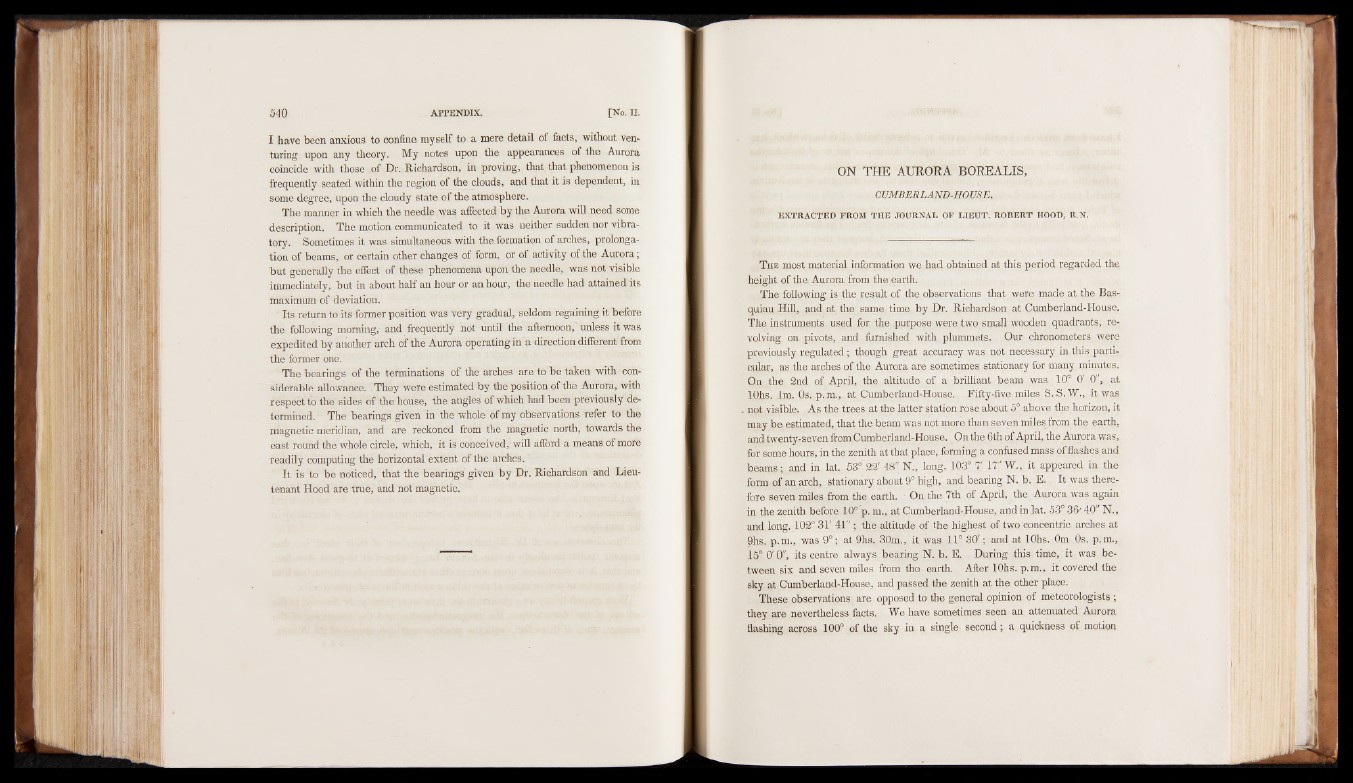
I have been anxious to confine myself to a mere detail of facts, without venturing
upon any theory. My notes upon the appearances of the Aurora
coincide with those of Dr. Richardson, in proving, that that phenomenon is
frequently seated within the region of the clouds, and that it is dependent, in
some degree, upon the cloudy state of the atmosphere.
The manner in which the needle was affected by the Aurora will need some
description. The motion communicated to it was neither sudden nor vibratory.
Sometimes it was simultaneous with the. formation of arches, prolongation
of beams, or certain other changes of form, or of activity of the Aurora;
but generally the effect of these phenomena upon the needle, was not visible
immediately, but in about half an hour or an hour, the needle had attained its
maximum of deviation.
Its return to its former position was very gradual, seldom regaining it before
the following morning,' and frequently not until the afternoon, unless it was
expedited by another arch of the Aurora operating in a direction different from
the former one. '•
The bearings of the terminations of the arches are to be taken with considerable
allowance. They were estimated by the position of the Aurora, with
respect to the sides of the house, the angles of which had been previously determined.
The bearings given in the whole of my observations refer to the
magnetic meridian, and are reckoned from the magnetic north, towards the
east round the whole circle, which, it is conceived, will afford a means of more
readily computing the horizontal extent of the arches.
It is to be noticed, that the bearings given by Dr. Richardson and Lieutenant
Hood are true, and not magnetic.
ON THE AURORA BOREALIS,
CUMBERLAND-HOUSE,
EXTRACTED PROM THE JOURNAL OF LIEUT. ROBERT HOOD, R.N.
T he most material information we had obtained at this period regarded the
height of the Aurora from the earth.
The following is the result of the observations that were made at the Bas-
quiau Hill, and at the same time by Dr. Richardson at Cumberland-House.
The instruments used for the purpose were two small wooden quadrants, revolving
on pivots, and furnished with plummets. Our chronometers were
previously regulated; though great accuracy was not necessary in this particular,
as the arches of the Aurora are sometimes stationary for. many minutes.
On the 2nd of April, the altitude of a brilliant beam was 10° 0' 0", at
lOhs. lm. Os. p.m., at Cumberland-House,, Fifty-five miles S.S.W., it was
not visible. As the trees at the latter station rose about 5° above the horizon, it
may be estimated, that the beam was not more than seven miles from the earth,
and twenty-seven from Cumberland-House. On the 6th of April, the Aurora was,
for some hours, in the zenith at that place, forming a confused mass of flashes and
beams; and in lat. 53° 22' 48" N„ long. 103° 7' 17" W„ it appeared in the
form of an arch, stationary about 9° high, and bearing N. b. E. It was therefore
seven miles from the earth. On the 7th of April, the Aurora was again
in the zenith before 10° p.m., at Cumberland-House, and in lat. 53° 36'40''N.,
and long. 102° 31' 41" ; the altitude of the highest of two concentric arches at
9hs. p.m., was 9°; at 9hs. 30m., it was 11° 30'; and at lOhs. 0m 0s. p.m.,
15° 0' 0", its centre always bearing N. b. E. During this time, it was between
six and seven miles from the earth. After lOhs. p.m., it covered the
sky at Cumberland-House, and passed the zenith at the other place.
These observations are opposed to the general opinion of meteorologists ;
they are nevertheless facts. We have sometimes seen an attenuated Aurora
flashing across 100° of the sky in a single second; a quickness of motion